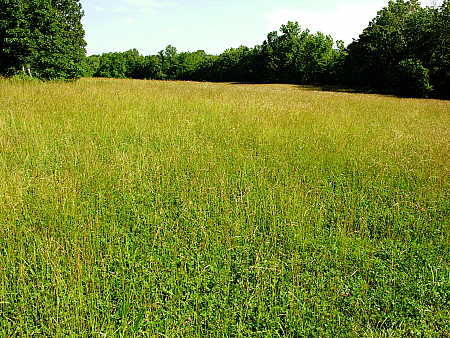
Perhaps you recall seeing this picture before on the Ranch Ramblins blog. I used this photograph in a post entitled Fescue To The Rescue, which extolled the virtues and cautioned about the vices of fescue grass. The picture was taken on June 8, 2006, and at the time of the photo this fescue/clover field, as well as several others, were in prime condition to be cut, dried and baled into large round bales for winter feeding of local cattle.
Early this past spring, I had made arrangements with a neighbor for baling this hay. The deal was a sweetheart deal from his point of view, as I offered him all of the hay and asked nothing in return. And what do I get out of the deal? About 20 fewer acres of grass that I need to cut using my own time, tractor and fuel. It was my hope to photograph the cutting, raking, drying, baling and hauling process, and to document these activities here on this blog. Alas, the best laid plans of mice and men sometimes go awry, and thus it was with this particular endeavor.
For reasons that most likely revolved around health concerns (this neighbor has had more than his share of medical problems) and recalcitrant equipment (40+ year old tractors, sickle-bar mowers, and hay rakes), the hay field went uncut. By the time I had realized that the neighbor wasn’t going to bale the hay, as previously arranged, it was too late to find someone with the time and equipment to bale these hay fields.
Last week I took the bush hog to this particular field, as you can see from the picture above. From a selfish point of view, I should be happy that things worked out the way that they did. Leaving the shredded fescue and clover to decompose in the field will be healthy for the grass in the long run, and the fescue was laden with seed, some of which will germinate next season as conditions warrant. The overall result will probably be healthier hay fields than would otherwise be the case had my neighbor baled the hay. On the other hand, with the persistent draught that has beset this region, hay prices have shot up through the roof, and I can’t help thinking that some local farmer, who might be struggling to make ends meet, would have loved to have 20 acres of fescue/clover hay for the taking.
Hopefully, next season I will have haying photographs to share with you.


